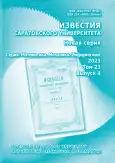Identification of two-dimensional prestress fields in inhomogeneous plates
- 作者: Bogachev I.V.1,2, Nedin R.D.1,2
-
隶属关系:
- I. I. Vorovich Institute of Mathematics, Mechanics and Computer Sciences, Southern Federal University
- South Federal University
- 期: 卷 23, 编号 4 (2023)
- 页面: 456-471
- 栏目: Articles
- URL: https://journal-vniispk.ru/1816-9791/article/view/250861
- DOI: https://doi.org/10.18500/1816-9791-2023-23-4-456-471
- EDN: https://elibrary.ru/POZOJY
- ID: 250861
如何引用文章
全文:
详细
作者简介
Ivan Bogachev
I. I. Vorovich Institute of Mathematics, Mechanics and Computer Sciences, Southern Federal University; South Federal University
ORCID iD: 0000-0002-4725-5102
Scopus 作者 ID: 54896501000
Researcher ID: H-7903-2016
8A Milchakova St., Rostov-on-Don 344090, Russia
Rostislav Nedin
I. I. Vorovich Institute of Mathematics, Mechanics and Computer Sciences, Southern Federal University; South Federal University
ORCID iD: 0000-0003-4366-9591
8A Milchakova St., Rostov-on-Don 344090, Russia
参考
- Ватульян А. О., Дударев В. В., Недин Р. Д. Предварительные напряжения: моделирование и идентификация. Ростов-на-Дону : Изд-во ЮФУ, 2015. 206 с.
- Carpinteri A., Pugno N. Thermal loading in multi-layer and/or functionally graded materials: Residual stress field, delamination, fatigue and related size effects // International Journal of Solids and Structures. 2006. Vol. 43, iss. 3–4. P. 828–841. https://doi.org/10.1016/j.ijsolstr.2005.05.009
- Дородов П. В., Поспелова И. Г. Исследование напряженного состояния в пластине, ослабленной концентратором напряжений // Достижения науки и техники АПК. 2013. № 8. С. 67–70.
- Schajer G. S. Practical Residual Stress Measurement Methods. Wiley, 2013. 560 p.
- Guo J., Fu H., Pan B., Kang R. Recent progress of residual stress measurement methods: A review // Chinese Journal of Aeronautics. 2021. Vol. 34, iss. 2. P. 54–78. https://doi.org/10.1016/j.cja.2019.10.010
- Uzun F., Korsunsky A. M. The use of eigenstrain theory and fuzzy techniques for intelligent modeling of residual stress and creep relaxation in welded superalloys // Materials Today: Proceedings. 2020. Vol. 33, iss. 4. P. 1880–1883. https://doi.org/10.1016/j.matpr.2020.04.910
- Ma W., Zhang H., Zhu W., Xu F., Yang C. Study on Residual Stress of Welded Hoop Structure // Applied Sciences. 2021. Vol. 10, iss. 8. Art. 2838. https://doi.org/10.3390/app10082838
- Li N., Zhang M., Ye J.-L., Liu C. Experimental investigation on residual stress distribution in zirconium/titanium/steel tri-metal explosively welded composite plate after cutting and welding of a cover plate // Journal of Manufacturing Processes. 2021. Vol. 64. P. 55–63. https://doi.org/10.1016/j.jmapro.2021.01.034
- Yi S., Wu Y., Gong H., Peng C., He Y. Experimental Analysis and Prediction Model of Milling-Induced Residual Stress of Aeronautical Aluminum Alloys // Applied Sciences. 2021. Vol. 11, iss. 13. Art. 5881. https://doi.org/10.3390/app11135881
- Huang C., Wang L., Wang K. Residual stress identification in thin plates based on modal data and sensitivity analysis // International Journal of Solids and Structures. 2022. Vol. 236–237, iss. 4. Art. 111350. https://doi.org/10.1016/j.ijsolstr.2021.111350
- Nedin R. D., Vatulyan A. O., Bogachev I. V. Direct and inverse problems for prestressed functionally graded plates in the framework of the Timoshenko model // Mathematical Methods in the Applied Sciences. 2018. Vol. 41, iss. 4. P.1600–1618. https://doi.org/10.1002/mma.4688
- Nedin R. D. Modeling and frequency analysis of prestressed functionally graded plates with holes // Computational Continuum Mechanics. 2019. Vol. 12, iss. 2. P. 192–201. https://doi.org/10.7242/1999-6691/2019.12.2.17
- Bogachev I. V. Determination of Prestress in Circular Inhomogeneous Solid and Annular Plates in the Framework of the Timoshenko Hypotheses // Applied Sciences. 2021. Vol. 11, iss. 21. Art. 9819. https://doi.org/10.3390/app11219819
- Nedin R. D., Vatulyan A. O. Inverse Problem of Non-homogeneous Residual Stress Identification in Thin Plates // International Journal of Solids and Structures. 2013. Vol. 50, iss. 13. P. 2107–2114. https://doi.org/10.1016/j.ijsolstr.2013.03.008
- Жуков М. Ю., Ширяева Е. В. Использование пакета конечных элементов FreeFem++ для задач гидродинамики, электрофореза и биологии : учеб. пособие. Ростов-на-Дону : Изд-во ЮФУ, 2008. 256 с.
- Ватульян А. О. Коэффициентные обратные задачи механики. Москва : Физматлит, 2019. 272 с.
- Богачев И. В., Ватульян А. О., Дударев В. В., Лапина П. А., Недин Р. Д. Идентификация свойств неоднородной пластины в рамках модели Тимошенко // Известия Саратовского университета. Новая серия. Серия: Математика. Механика. Информатика. 2017. Т. 17, вып. 4. С. 419–430. https://doi.org/10.18500/1816-9791-2017-17-4-419-430
- Nedin R. D., Vatulyan A. O., Dudarev V. V., Bogachev I. V. Detection of nonuniform residual strain in a pipe // International Journal of Solids and Structures. 2018. Vol. 139–140. P. 121–128. https://doi.org/10.1016/j.ijsolstr.2018.01.026
- Тихонов А. Н., Арсенин В. Я. Методы решения некорректных задач. Москва : Наука, 1986. 288 с.
- Ватульян А. О., Богачев И. В. О проекционном методе идентификации характеристик неоднородных тел // Доклады Академии наук. 2018. Т. 478, № 5. С. 532–535. https://doi.org/10.7868/S0869565218050079, EDN: YPEEZO
补充文件










